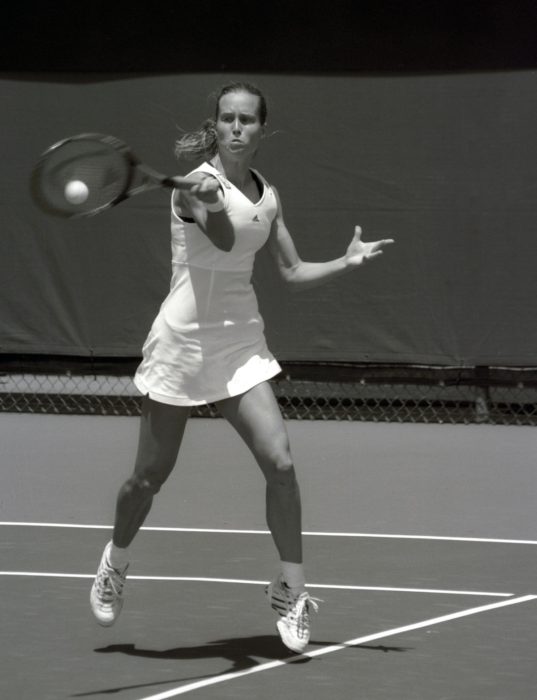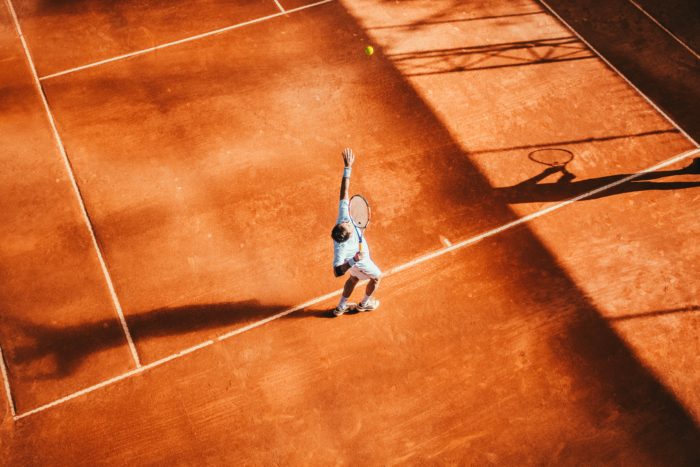*This article may contain product links which pay me a small commission if you make a purchase. Learn more.
There’s been a ton of Fanfare regarding Steve Delabar, a former independent pitcher who went through Tom House’s NPA Pitching Velocity program, jumped into the mid-90s and resurged into a big leaguer shortly thereafter. It’s a great story and people should be excited about it.
But, House credits Tennis for his epiphany in developing the program of “holds” – throwing a ball without releasing it. In an article interview from Inside Pitch Magazine House says the following:
We stumbled on the fact that tennis players never have GIRD [a deficit in shoulder internal rotation range of motion] and after 45 years of watching pitchers come up with shoulder injuries, we asked ourselves why don’t these tennis players have bad shoulders? The answer is because they hang on to the racket through accelerator and decelerator actions.
I agree that tennis shoulder injuries are indeed lower than those of baseball pitchers. I don’t have the numbers but I wouldn’t even bother – baseball’s are astronomical.

But, House’ Tennis Analogy oversteps his bounds, and my logic and causation alarm goes off when anyone says “The answer is” regarding the human body. The fact is, Tom House’s claim is conjecture – not fact. He doesn’t KNOW; he assumes, believes, posits, hypothesizes.
That’s OK – all good research starts with a hypothesis. But, he’s doing all of us a disservice if he’s really convincing parents, coaches and players that the only difference between the two sports is the racket. It’s not. This is really an apples-to-oranges comparison and a poor analogy.
And, I think I can explain why tennis players don’t exhibit GIRD (hint: it’s about the follow-through).
5 Reasons The Tennis Analogy Is Not a Good One
1. The tennis serve involves high-speed elbow extension, not internal rotation.
This study explains the force to which the elbow is subject during the serve. It details how the elbow quickly accelerates, in elbow extension, at 982 degrees per second prior to contacting the ball. Though the elbow is NOT what we’re looking at here, this notion is important. Shoulder motion dictates elbow motion.
It’s clear that because the elbow extends, not rotates, to strike the ball, that the shoulder is also not violently rotating like in a baseball throw. Yes, the shoulder does lay back, like the arm of a pitcher, but it does so earlier and this rotation is undone prior to accelerating to strike the tennis ball. Shoulder internal rotation in an elite pitcher can reach 7,000 degrees per second or more.
If tennis players struck the ball with exactly the same mechanics that a baseball pitcher throws with, then the analogy would be easier to swallow. But they don’t. This is an example of a logical fallacy: Faulty analogy.
Conclusion: We can’t rule out the possibility that the difference in mechanics and lack of explosive internal rotation in the tennis serve is the cause for lower injury rates. The serve and the throw are very different.
2. Tennis players don’t just serve. They hit groundstrokes from all different angles.
Baseball players typically throw from a consistent arm angle, especially elite ones.
Tennis players, however hit the ball overhead, sidearm, and every angle in between – it depends on the ball. Baseball players don’t do this.

The tennis player also hits many more ground strokes than serves. This means they spend more time with their shoulder at or below shoulder height, something that is proven to relieve shoulder impingement.
Shoulder impingement happens when the arm is raised to shoulder height or above. To impinge is for two surfaces to contact. The rotator cuff muscles strike the acromion, which can cause pain and wear and tear. Tennis players most certainly spend less time in impingement than baseball players due to groundstrokes.
Conclusion: Groundstrokes in tennis players could account for shoulder injury decrease because of decreased stress on the shoulder joint. There is no way to rule this possibility out.
3. Tennis Players Hit Backhands
Baseball pitchers internally rotate to throw a pitch. This means that three of the four rotator cuff muscles are eccentrically decelerating, not accelerating the ball. Thus, these three muscles – the supraspinatus, infraspinatus and teres minor – rarely get any concentric strengthening in the sport itself. This is not the case in tennis.
Rather, tennis players hit backhands, which is a concentric exercise for the scapula retractors, external rotators of the cuff and other back muscles. When Tom House talks about balance, he seems to forget that Tennis players get balance in their musculature from hitting backhands. Baseball players do not get this.
Conclusion: The backhand appears to strengthen the rotator cuff and back muscles in a way that the baseball throw cannot. This strengthening could be a large reason tennis shoulders resist injury.
4. Repetition in Tennis is higher.
Tennis players hit A LOT. Every day they hit hundreds and hundred of balls, which can potentially strengthen the shoulder in ways that lesser repetitions can’t.

I don’t know the role high repetition plays for the tennis player, but it’s hard to compare the workloads of two different sports with two massively different workloads. Baseball pitchers throw hard only a few times per week. Tennis players, especially when competing, can hit at a high intensity for hundreds upon hundreds of reps. And, that’s not counting the many more lower-intensity reps they get in practice.
Conclusion: The workloads of the tennis player and baseball player vary greatly. It’s hard to rule out the workload’s role in injury.
5. Acceleration Patterns Are Different
Because the tennis ball is so light, and the racket weight constant, the tennis serve and stroke may have a smoother acceleration pattern than a baseball throw. But, a baseball player accelerates a 5oz ball to, say 90mph. If the arm is going 90mph prior to release, once at release – the moment the ball is no longer being pushed by the arm – the arm should speed up. This is, of course, immediately followed by deceleration.
The tennis player strikes the much lighter (2 ounces) tennis ball, which causes a momentary deceleration. Because the tennis racket collides with the ball, the arm must slow down, even if only slightly, because the ball has weight that the racket and arm must absorb before the ball’s force is redirected.
Conclusion: The tennis hit involves a collision, but the baseball throw has no such collision; common sense says that the pitcher’s arm should speed up slightly once it’s no longer burdened by the 5oz baseball. This makes the acceleration and deceleration pattern much different, which could account for injury rates.
So, Do “Holds” Hold Water?
Not from the racket analogy; that much is for sure.
There are too many variables, as explained above, that could account for the disparity in injury rates. No one should buy the “the racket is the reason,” reason. It just isn’t that simple – the answer appears to be multivariate.
Part of my incredulity is the idea that balance can only be achieved by decelerating the weight that one is accelerating. If the rotator cuff’s imbalance is the problem, why can’t rotator cuff strengthening exercises held rectify the imbalance? Why is “hold training” the best way to do so?
After all, tennis players get concentric rotator cuff work from their backhands – shouldn’t baseball players as well? Many players do “reverse throws,” popularized by Ron Wolforth and other great pitching minds. A video is below, and it’s basically the same for the pitcher as the backhand is for the tennis player.
Do Strong, Well-Conditioned Pitchers Benefit From Holds?
If GIRD and relative muscle weakness and imbalance is the problem, is a holds-based program only relevant to those who aren’t doing the right things in the first place? Even in the minor leagues, like Delabar and the two minor leaguers mentioned in the House article, pitchers aren’t necessarily well-conditioned or as strong and stable as they should be in their pitching arm.
Work ethic plays a big role in all levels of sports. So basically, if you have GIRD and a weak, unstable throwing arm, holds might be the first dose of good medicine, resulting in a velocity gain. But, a high-quality rotator cuff and scapular stability program might have the same results.
Personally, as a pitcher and strength coach who takes immaculate care of himself, I’m doubtful that holds would do much, if anything for me. I can already throw in the 90s. I don’t have GIRD. I have a very strong, balanced rotator cuff and take constant care to get stronger. Would holding onto a ball whilst throwing really make me better? Maybe – the verdict is out. But, since I don’t exhibit the symptoms that this type of training supposedly cures, it seems doubtful.
What Then, Causes The Lack of GIRD in Tennis Players?
Here’s my guess, and let me go on the record as recognizing that this is conjecture:
The cross-body stretch has been shown to be very effective in reducing GIRD, perhaps more so than the sleeper stretch. This stretch is commonly prescribed to baseball players to alleviate their GIRD. Here’s a video:
The cross-body stretch basically involves moving the upper arm across the body (duh). What other movement is very, very similar? The forehand follow-through in Tennis. Every time a tennis player wallops a forehand, his arm follows through across his body. Perhaps it is this repetitive motion that keeps the arm loose and in proper range of motion, not the tennis racket itself.
Watch for yourself. It’s basically like the cross-body stretch is built into the sport, repeated hundreds of times daily. It seems very plausible that THIS is the reason tennis players don’t have GIRD.
For the record, I’m not anti-Tom House. Not at all. I simply think people need to really think about why they’re doing what they’re doing. If a holds program excites a pitcher and gets him to do something, then fantastic – I don’t view it as any more potentially injurious than regular throwing, so why not?
And, as one coach mentioned, it may be an easy at-home exercise for his pitchers without supervision – grab a ball in a sock and throw it. That’s good too.
But, his argumentation is poor and hence this article. I’m simply not convinced that it’s better training than other forms. And, with a finite amount of training time, we prioritize other methods. I’m open to counterarguments, though, so please leave comments below.